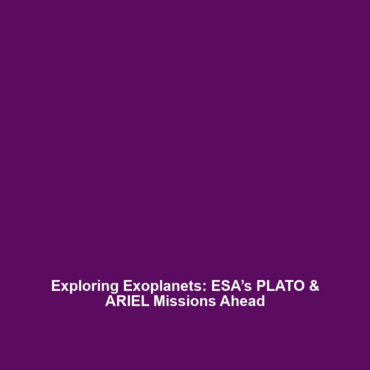Upcoming Missions: ESA’s PLATO and ARIEL in Exoplanet Exploration
As the quest to understand exoplanets continues, upcoming missions such as ESA’s PLATO (PLAnetary Transits and Oscillations of Stars) and ARIEL (Atmospheric Remote sensing Infrared Exoplanet Large survey) promise to revolutionize our knowledge of worlds beyond our solar system. These missions are significant because they aim to study the characteristics and atmospheres of exoplanets in unprecedented detail, thus providing crucial insights into their habitability and formation. Understanding these missions is essential within the broader context of exoplanet research, as they represent a leap forward in technology and knowledge.
Key Concepts of Upcoming Missions
ESA’s PLATO and ARIEL missions are designed to tackle several fundamental questions in exoplanet science:
- PLATO’s Objectives: Focused on detecting and characterizing Earth-like exoplanets, PLATO will utilize a network of telescopes to monitor thousands of stars for transits, providing valuable data on planet sizes and orbit periods.
- ARIEL’s Goals: ARIEL aims to study the atmospheres of a wide variety of exoplanets, revealing their chemical compositions and thermal profiles. This mission will help identify potential biomarkers that indicate habitability.
- Importance of Exoplanet Research: Understanding exoplanets is crucial for determining whether life exists beyond Earth and understanding the diversity of planetary systems in our galaxy.
Applications and Real-World Uses
The upcoming missions, especially PLATO and ARIEL, offer significant applications in the field of astronomy and beyond:
- How PLATO and ARIEL are used in exoplanet exploration: These missions will provide data that can assist in the search for potentially habitable worlds, broadening our understanding of planetary formation and evolution.
- Applications of exoplanet exploration: Discoveries made by these missions could inform the development of future space missions aimed at direct exploration of exoplanets, as well as impact fields such as astrobiology and planetary science.
Current Challenges in Exoplanet Missions
Despite the excitement surrounding these upcoming missions, several challenges remain:
- Challenges of accurate measurements: Precise detection of exoplanets and their atmospheres requires highly sensitive instruments that can operate in the harsh environment of space.
- Issues in data interpretation: Analyzing the complex data returned by missions like ARIEL and PLATO poses a significant challenge for scientists, as it requires sophisticated modeling techniques.
- Funding and resource allocation: Securing ongoing funding and resources for these long-term missions can be difficult amidst competing scientific priorities.
Future Research and Innovations
Looking ahead, innovations associated with the PLATO and ARIEL missions will likely shape the future of exoplanet exploration:
- Next-gen telescopes: Advancements in telescope technology are being developed, enhancing our capacity to observe distant worlds.
- Breakthroughs in atmospheric science: ARIEL’s focus on understanding planetary atmospheres may lead to significant breakthroughs in our knowledge of climate and atmospheric chemistry.
Conclusion
In summary, upcoming missions like ESA’s PLATO and ARIEL are poised to significantly enhance our understanding of exoplanets and their potential for supporting life. As these missions gear up for launch, they promise to provide unprecedented insights into the nature of these distant worlds. For those interested in the future of space exploration and the ongoing search for habitable planets, following these developments will be crucial. For more information on exoplanets, consider exploring our articles on related topics, such as the characteristics of habitable zones and the search for extraterrestrial life.
